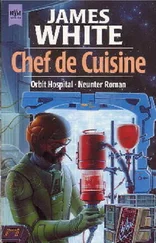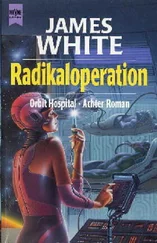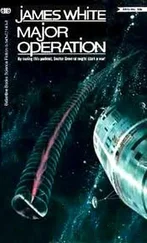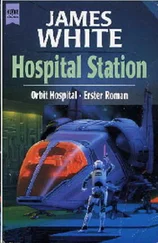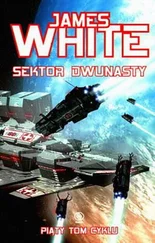“I mean you no harm,” he said. “If you are in trouble, sick, injured, or malfunctioning, I want to help you. Disregard my liter shape and that of the other person who was with me, and the others you may meet. We must look strange and frightening to you, but we all mean you well…”
He repeated the message while continuing to project reassurance, sympathy, and friendship at maximum intensity and, while doing so, he moved his hand to the middle of the robot’s body and changed his touch into a soft, gentle push.
Abruptly it released its grip on the netting with four of its hands and used the other two to pull itself rapidly away from him. It was about to disappear forward beyond the range of his light when it paused and began to move back towards him again. When it was about five meters distant it stopped, then began to move away more slowly.
Plainly it wanted him to follow it, which, after a moment of fearful hesitation, he did.
The passageway was leading directly towards a complex structure that seemed to fill the interior of the vessel’s bow section. The bracing members radiating from it and the framework of the passageway he was following were festooned with cable looms, many showing the distinctive color-coding of the outer hull’s sensor network.
He was beginning to feel something.
“Are you doing this,” he called ahead to the to the robot he was following, “or is it your superintelligent captain robot?”
It continued moving forward without replying. There was nothing on its silvery body surface that resembled a mouth, so probably it couldn’t.
The feeling that came to him was so tenuous that it verged on the insubstantial, but it was increasing slowly in strength. At first he was unsure whether it was originating from one mind or a group of them; then he decided that it was coming from two separate thinking and feeling beings. Both of them felt distressed and frightened, and, as well, one was puzzled and intensely curious while the other was radiating the claustrophobic panic characteristic of close confinement and sensory deprivation.
So far as he could feel, neither of them were in any pain nor were they exhibiting the fear characteristic of imminent termination, but then, he thought, thinking robots might not have such feelings. For a more accurate emotional reading he needed to get much closer to them, but that was triply impossible.
He was at the end of the passage and facing the solid wall of the structure that probably housed them. Although there was a convenient panel filled with colored buttons and switches, he had no idea of the operating principles of the actuator mechanism that would allow entry or the damage he might do — not least to himself — if he tried and failed. And most important of all, he was fast running out of conscious time.
Prilicla was still frightened but for some odd reason he no longer felt threatened by his situation. Still, it would be considered an act of utter stupidity and carelessness if he were to fall asleep in the middle of an alien starship.
When Prilicla wakened he felt rested and clearheaded but he was also feeling, in spite of the source being half the ship’s length away, the angry impatience of the captain. He had been semicomatose from fatigue when he had returned from the alien vessel, and had not been able to make a coherent report, and now friend Fletcher was waiting to talk to him. The trouble was that he was still feeling so confused by his discoveries inside the ship that the report would sound incoherent. He needed more time to think.
Cowardice — both physical and moral — and procrastination were second nature to him. He flew down the central well to the casualty deck and used its communicator to contact Pathologist Murchison for a detailed report on the condition of Terragar’s casualties.
It told him that Captain Davidson and the two surviving officers were stable, responding to the limited treatment available in a temporary medical facility, and being maintained on a regimen of IV feeding and heavy sedation. Personally, it felt that the quarantine arrangements between the patients and the ambulance ship were totally unnecessary, and a rapid casualty transfer to Rhabwar and a fast return to Sector General for more aggressive treatment were indicated. It ended by saying that the investigation and first-contact situation with a bunch of intelligent robots was a technical matter and none of their medical business Prilicla was unable to detect the pathologist’s emotional radiation from orbit, naturally, but he could imagine the intense irritation and concern it and the rest of the team were feeling for their patients. He also knew that friend Fletcher would be routinely monitoring all radio traffic between the ship and the surface so that what he was about to say would mean that he could not delay speaking to the captain any longer.
“Friend Murchison,” he said gently, “I don’t foresee an immediate return to Sector General because the situation here is becoming more complicated. There are two other-species casualties on the alien vessel who may also require attention…”
“Other-species casualties!” it broke in. “Sir, with respect, we’re not running a bloody robot-repair shop down here.”
“You are assuming that the alien casualties are non-organic life forms,” he replied. “That may not be so. But I have no wish to answer the same questions twice, so keep your communications channel open and listen in while I talk to the captain. I can feel friend Fletcher very badly wanting to talk to me.”
“You’re right, Doctor,” said the captain as he flew onto the control deck a few minutes later. It gestured towards the communicator whose monitor light was showing and went on, “What was that all about? Other-species casualties? What did you find after I left you alone back there?”
Prilicla hesitated, but not for long because the other’s impatience was so intense that it was making him tremble. He said, “I’m not sure what it was that I found, and even less sure of what it means…”
Briefly he described the events following the captain’s departure for Rhabwar, the silent but obvious efforts of the robot crew member to entice him to follow it forward to the end of the central passageway where he could go no farther, and all that he had seen, thought, and felt there.
“… On the way back,” he continued, “I decided that I had enough time to spare before I fell asleep to explore the ship’s stern, and followed the passageway all the way aft. The inside of of that ship is like a three-dimensional spider’s web, with thin supporting and bracing members, open-netting passageways, and most of all, cable runs linking the major internal structures. Considering the color-coding on the majority of the cable looms I saw — especially those linking the microcircuitry underlying the ship’s outer hull to what is presumably the control center forward — there are close similarities in the overall structure to the layout of major organs, musculature, and central nervous system of an organic life-form. The skin is highly sensitive and we know how it can react to an attack, or what it thinks is an attack, by an outside agency.
“We were safe,” he went on quickly, “because we entered through the damaged hatch, which is analogous to a traumatized and desensitized surface wound. The forward structure obviously houses the brain and…”
“Wait, wait,” said the captain, holding up one hand. “Are you telling me that the whole ship is alive? That it’s an intelligent, self-willed star-travelingmachine like its robot crew members, only bigger? And that all that stopped you getting into its computer superbrain — or, from what we overheard you tell Pathologist Murchison, its two superbrains — was a simple, structural impediment and your lack of physical endurance?”
Читать дальше



